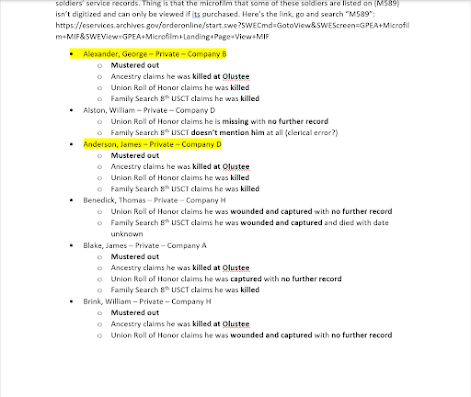Week 4 | Research Begins
Hey everyone, Aaron here. Just as I had expected, Week 4 ended up being very busy, both in the Olustee Project and in the work for my other classes—although I can say it could have been worse. This week, I worked from home every day. The professor for my in-person class unfortunately caught COVID, so they emailed us over the weekend and told us that our class on Tuesday would be online via Zoom. Fast forward to Tuesday, and the Zoom class was canceled altogether; I can only assume that my professor didn’t feel up to it. Hope she feels better soon. I had already known for a while that my Thursday class would not be in-person as I had an exam that day. My studying evidently paid off and I got a great score.
In an odd coincidence, Dr. Gannon also wasn’t able to make our normal Friday meeting since she’s on site at Olustee in north Florida meeting with a journalist that intends to interview her about the battlefield and the lack of a Union memorial there. In her stead, she provided us with a rough outline of the work us interns will be starting now. As I mentioned previously, we will be investigating the regiments that fought at Olustee with the highest casualty rates. I was tasked with investigating the 8th and the 35th US Colored Troops, which as the name suggests is mostly composed of African-American troops (I believe some of the officers were white). I also went ahead and purchased an Ancestry account for my own personal usage so I wouldn’t need to do all my investigation at the public computer in the Trevor Colburn hall at UCF Main. Dr. Gannon also plans to assign her military history class to these same regiments; she mentioned that she is still currently planning out the project to be adapted into a classwork form. In the meantime, the other interns and I are to get acquainted with sources that discuss our respective regiments.
Admittedly, I expected the research to be easier. I opened up a list of some sources Dr. Gannon was kind enough to include in her project summary from the outset, and while I found some good information about the 8th and the 35th on one of them, most of the links at the bottom of that page (which appeared to list some records on individual soldiers’ service histories) look to be dead. It might be worth using the Wayback Machine (a website with archives of terminated webpages) to see if the sites have been taken offline, but perhaps the links have simply been written wrong. I brushed that minor misstep aside and took a look at the spreadsheets we have with lists of casualties and soldiers that have been mustered out. Last week I mentioned how some mustered out soldiers were listed as such because they were killed—today I went ahead and cross-referenced the list of mustered out soldiers with those provided on the casualty spreadsheet. I checked each mustered out soldier’s status on Ancestry.com, and found that most of them were indeed killed at Olustee (or so the source claims; the original microfilm from the National Archives is locked behind a paywall and isn’t digitized). I then checked out each of these soldiers in the casualty spreadsheet, and found that some had been listed not as killed, but as captured with no further record. I’ll need to investigate this inconsistency; I imagine it is probably the result of unreliable reports of wounded but alive soldiers made by those who survived Olustee. Survivors might have reported seeing their comrades captured but had left the battlefield before they could confirm if they had died or not. These prisoners might have died at the site after retreat; the regiment wouldn’t have been able to confirm this until prisoner of war camps like Andersonville were liberated at the Civil War’s conclusion. My plan is to continue cross-referencing the lists until I’m done, then start looking for some external sources to back up my findings. I imagine Dr. Gannon’s class will be helping with that.

Comments
Post a Comment